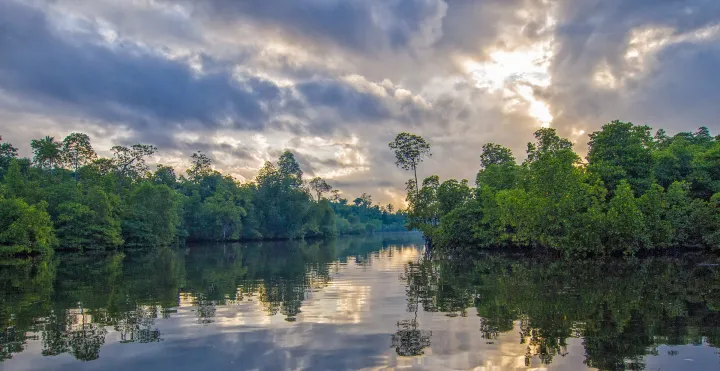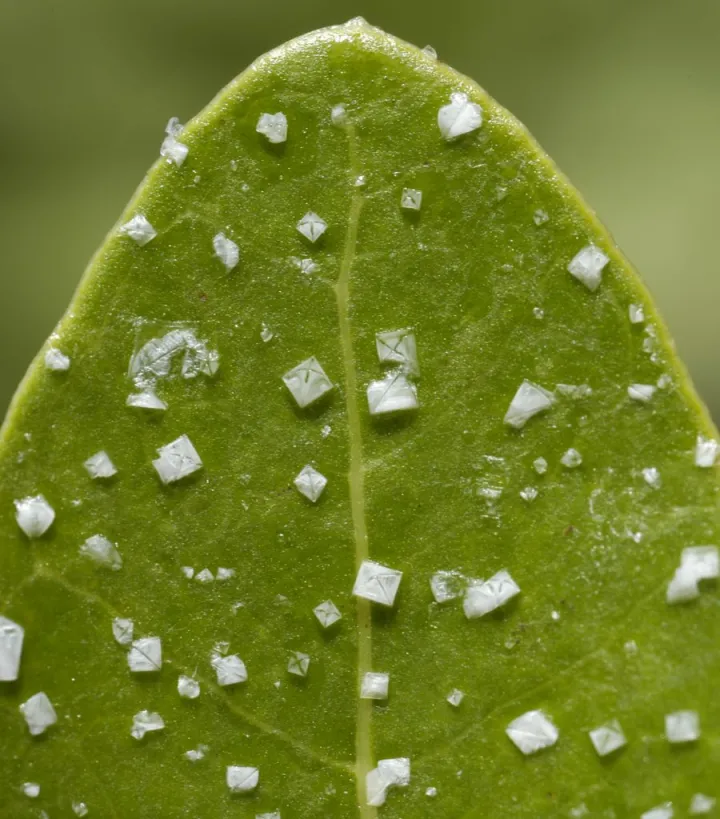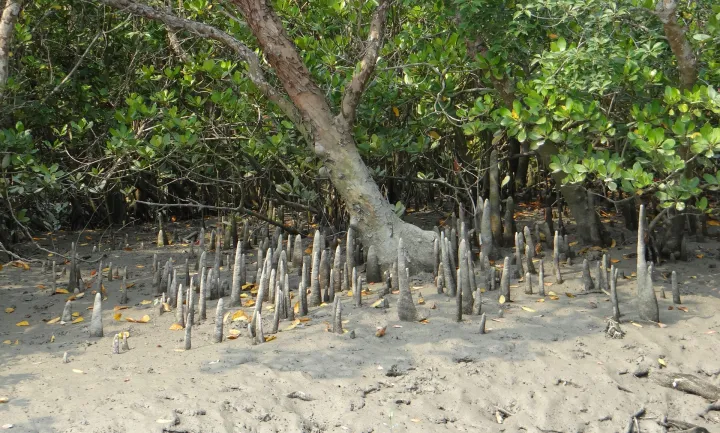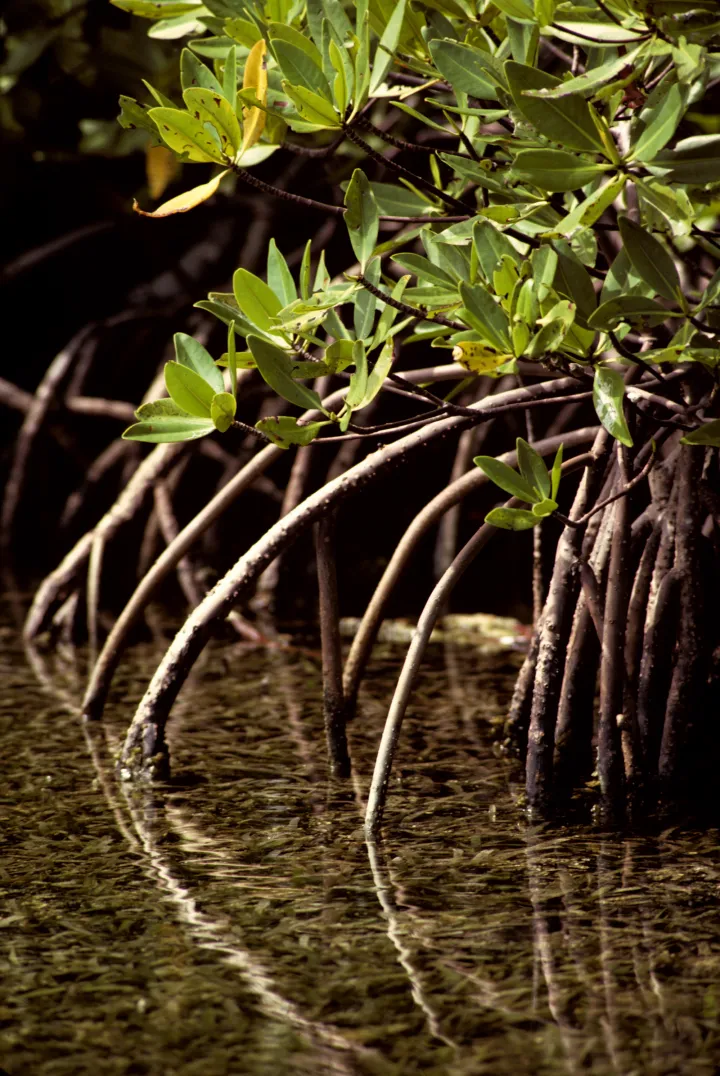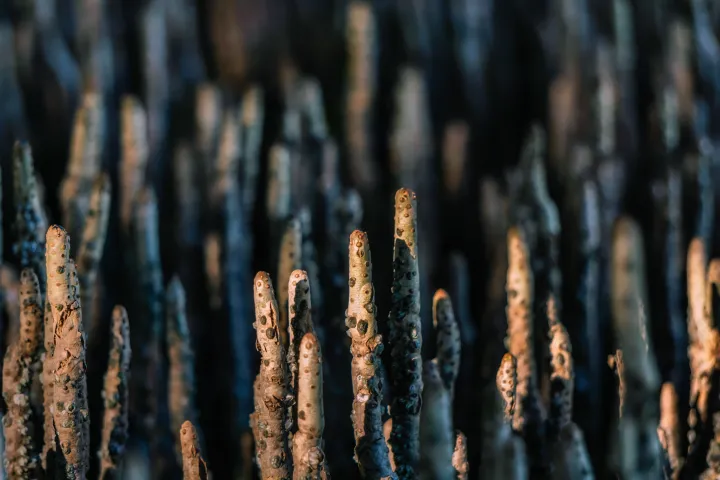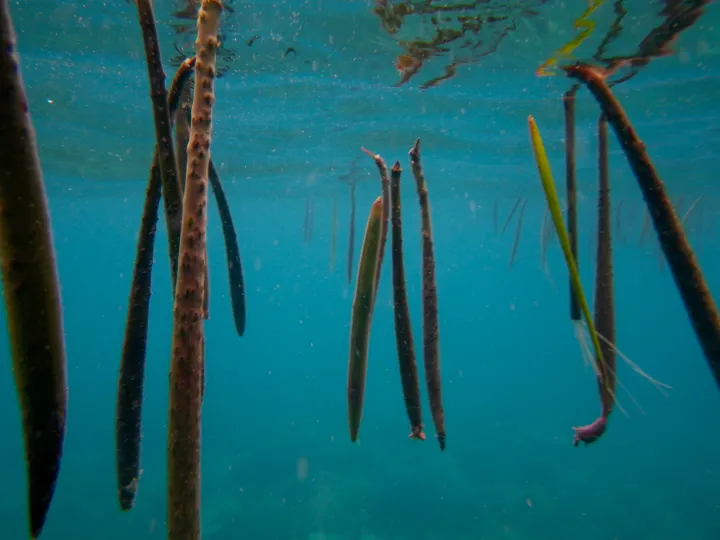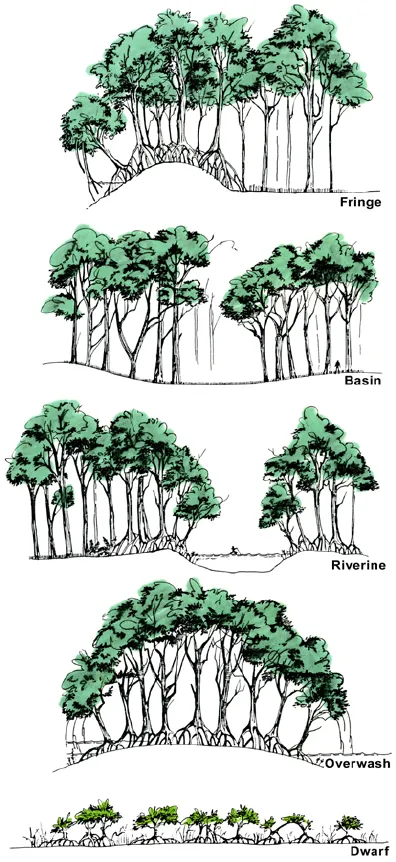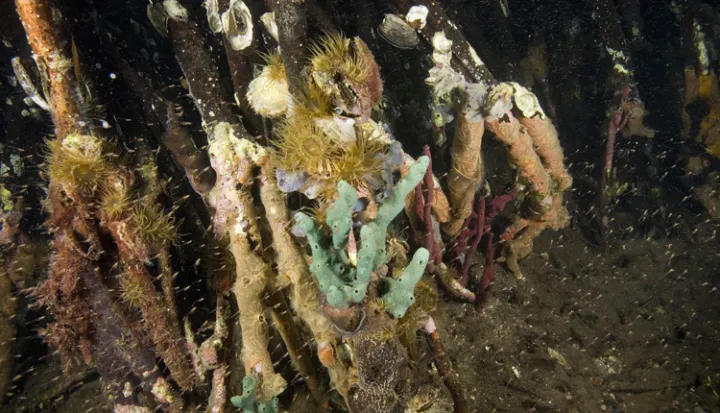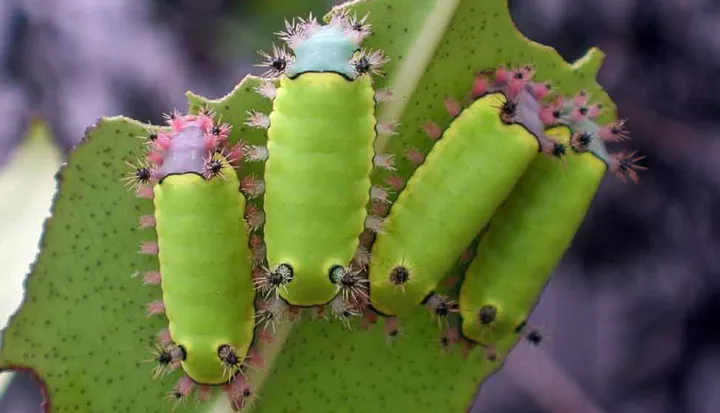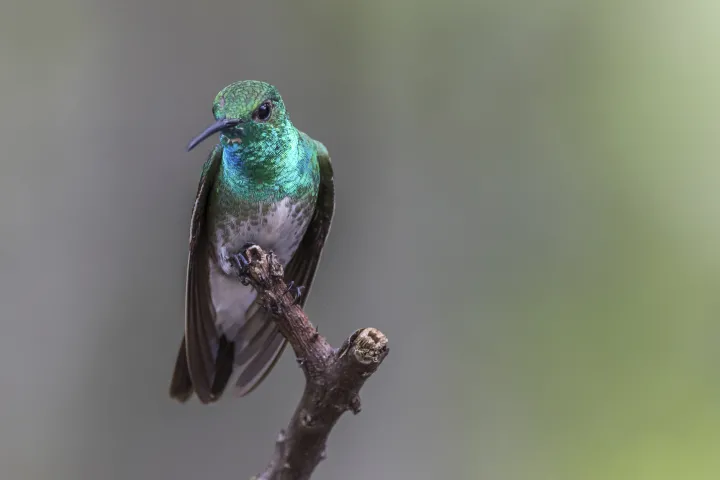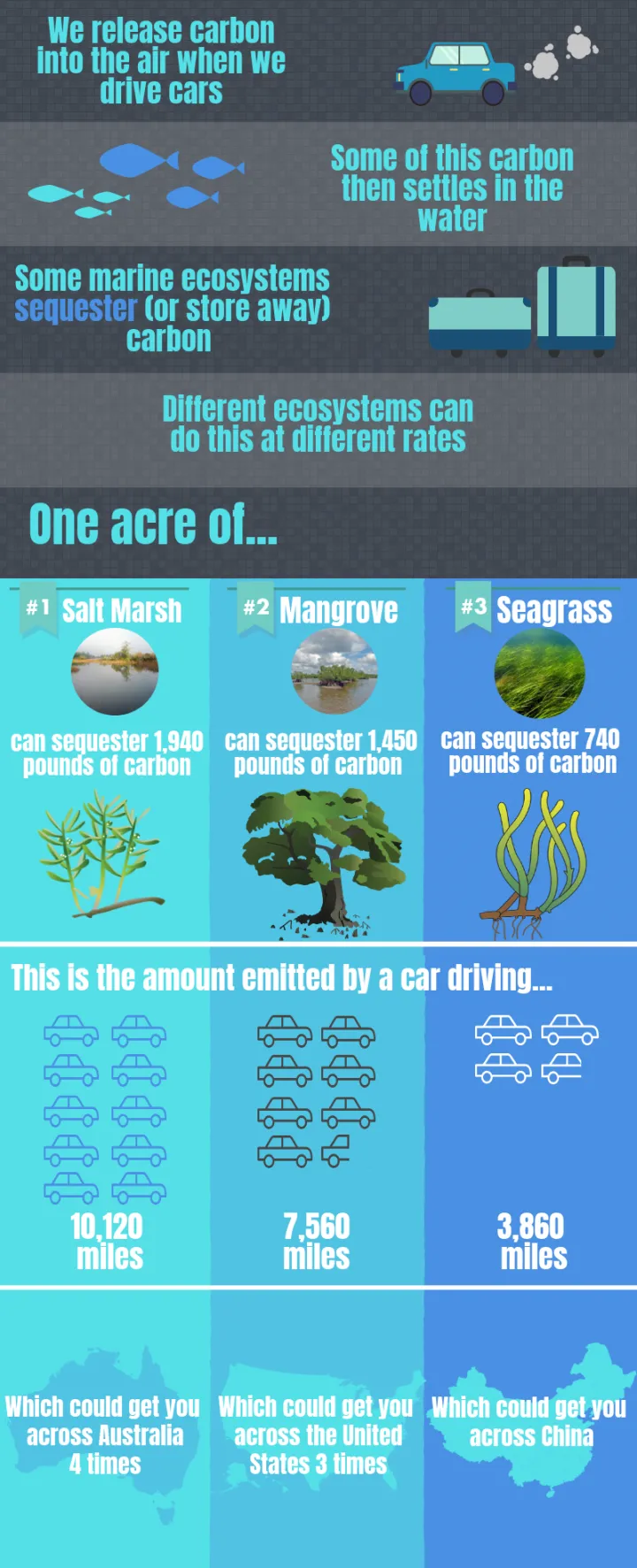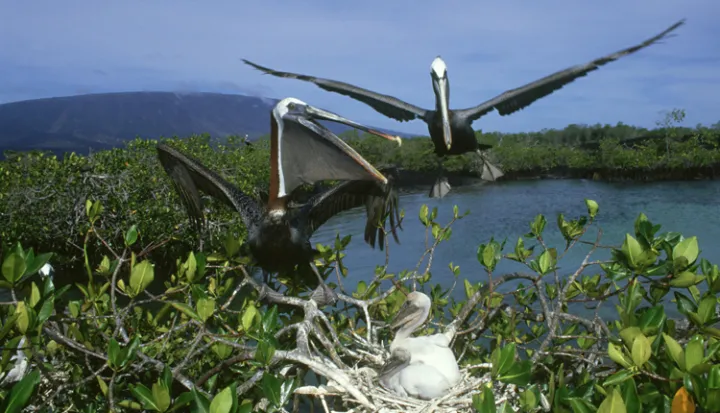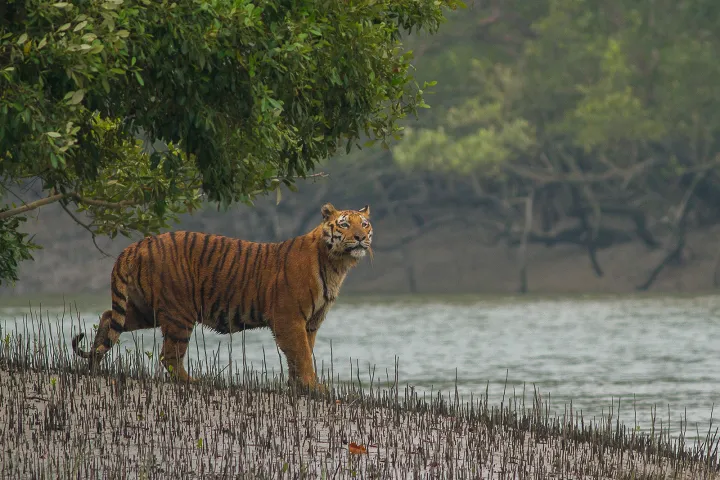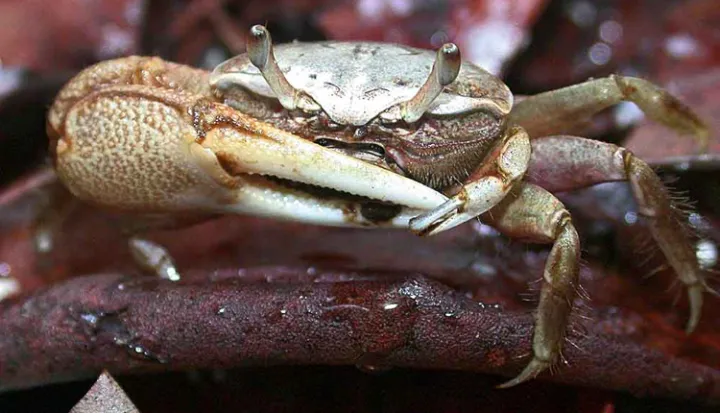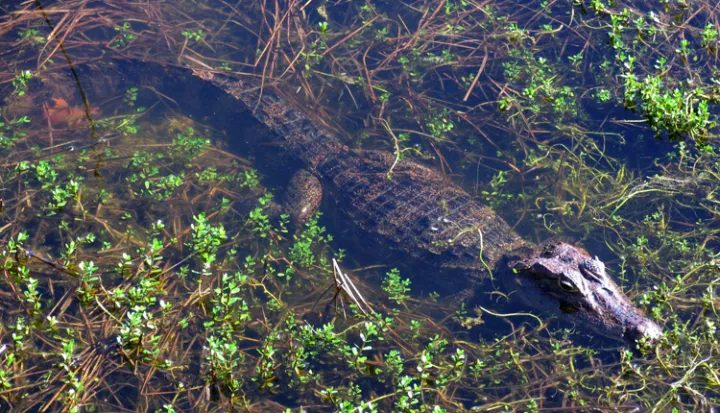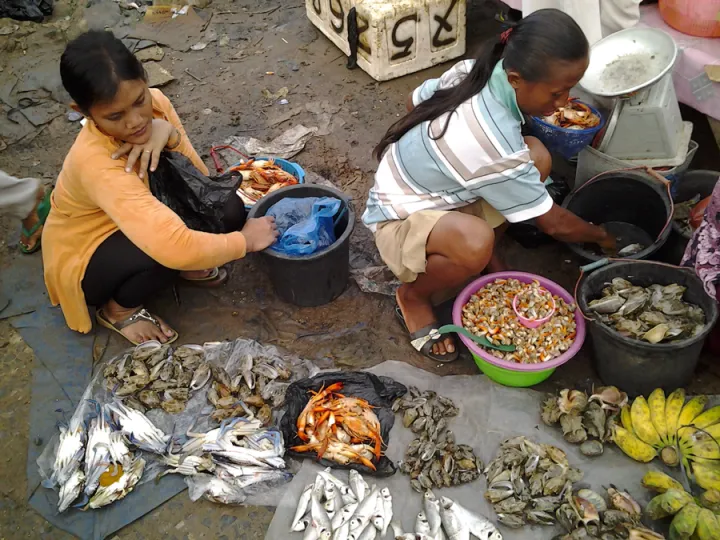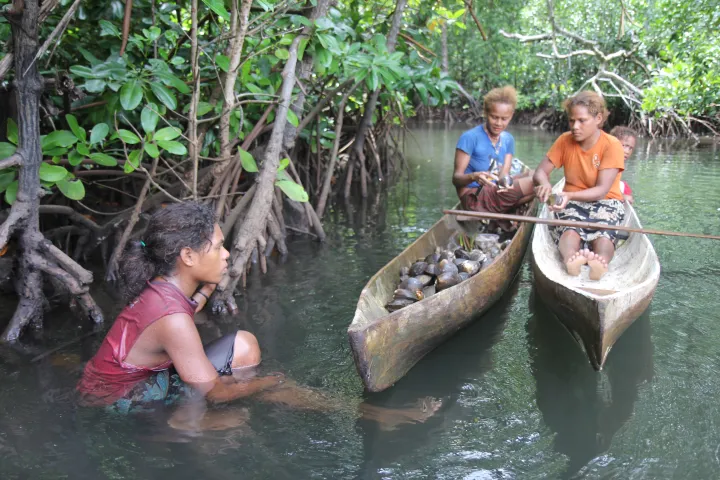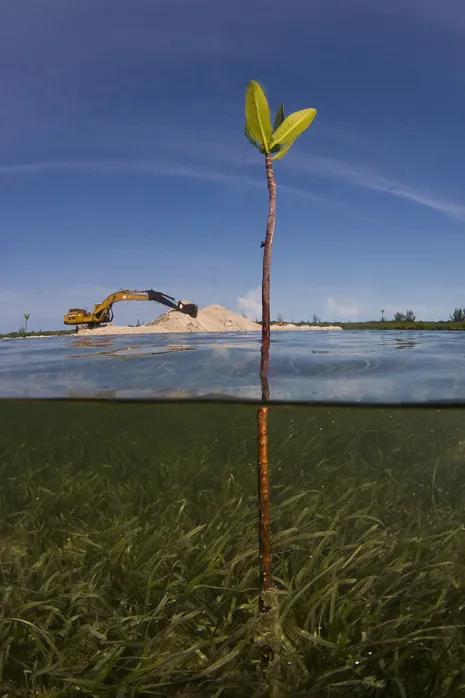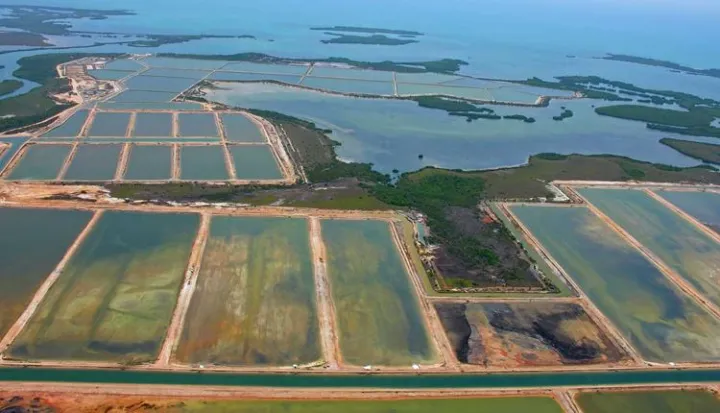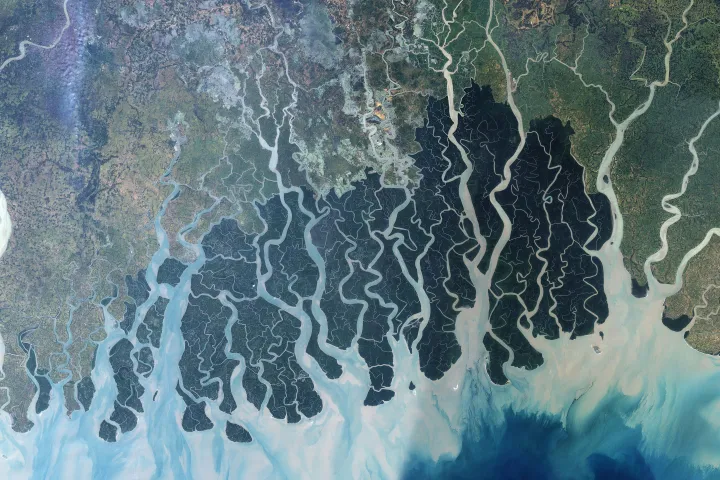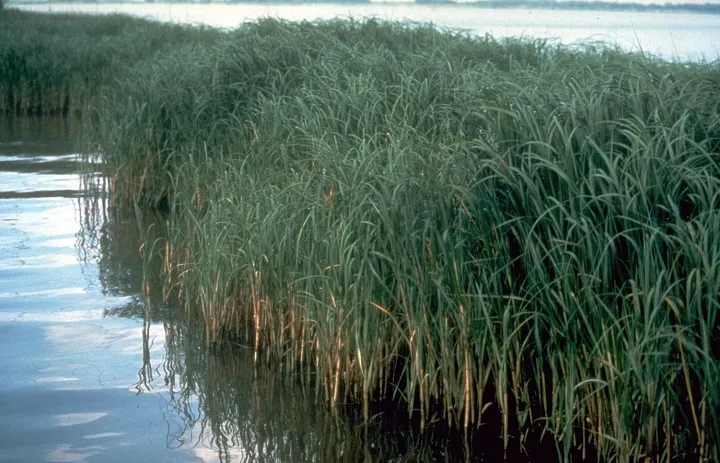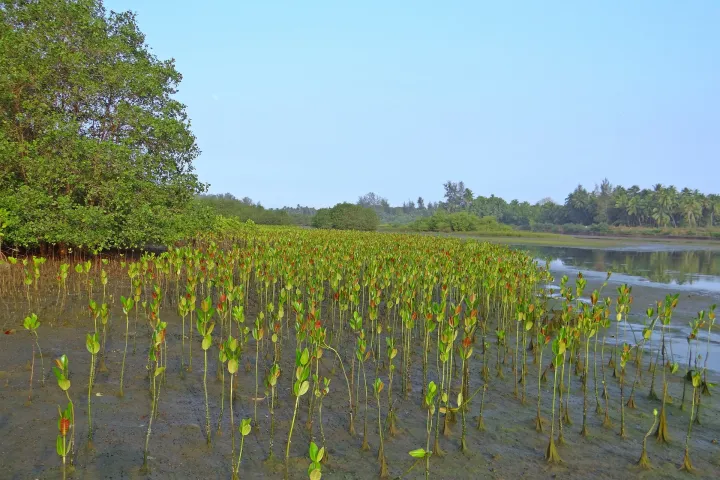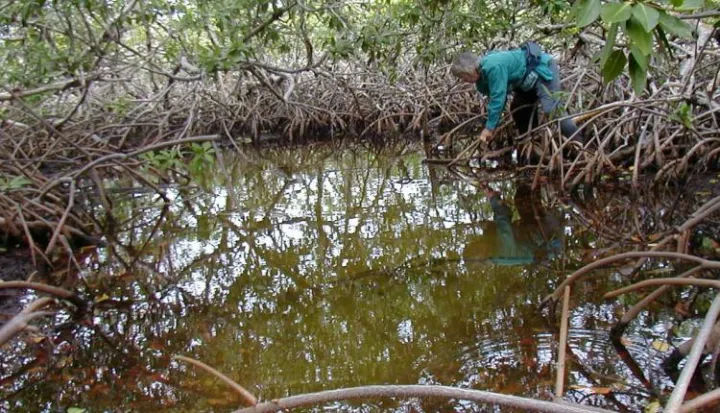
Mangroves
Introduction
Mangroves are survivors. With their roots submerged in water, mangrove trees thrive in hot, muddy, salty conditions that would quickly kill most plants. How do they do it? Through a series of impressive adaptations—including a filtration system that keeps out much of the salt and a complex root system that holds the mangrove upright in the shifting sediments where land and water meet. Not only do mangroves manage to survive in challenging conditions, the mangrove ecosystem also supports an incredible diversity of creatures—including some species unique to mangrove forests. And, as scientists are discovering, mangrove swamps are extremely important to our own well-being and to the health of the planet. The question is: Will mangroves be able to survive the impact of human activities?
What Are Mangroves?
Distant Relatives
A mangrove is a woody tree or shrub that lives along sheltered coastlines within the tropic or subtropic latitudes. In fact, the various species of mangroves aren’t necessarily closely related to one another, but they do share the unique capability of growing within reach of the tides in salty soil. Some mangrove species live so close to the shoreline that they are flooded with salt water every day as the tide comes in and submerges their roots. All mangroves have evolved special adaptations that enable them to live in salty, oxygen-poor soil.
Under the strictest guidelines, there are roughly 54 true species of mangrove belonging to 16 different families. However, because distinguishing a mangrove species is based upon physical and ecological traits rather than family lineage, scientists often differ in what they consider to be a true mangrove. Some species like Conocarpus erectus, the buttonwood, are often grouped with mangroves since they hug the upper edge of mangrove forests, however, they lack many of the characteristic adaptations of mangroves and are labeled “mangrove associates.” When all plants that live in a mangrove environment are accounted for, there are well over 80 mangrove species.
Mangrove can also be used as a term that refers to an entire community. The tree and shrub foliage create a rich habitat for other plants and animals to call home, and the branching root system underwater creates a safe haven for many fish, especially easily preyed upon young. Scientists will refer to this as the mangal, but mangrove or mangrove forest works just the same.
Where Are Mangroves Found?
Mangroves grow in sheltered tropical and subtropical coastal areas across the globe. In general, this is an area between latitudes of 25 degrees north and 25 degrees south, however, geographical limits are highly variable depending upon the area of the world and local climates. In Eastern Australia, the mangrove Avicennia marina can grow as far south as 38 degrees and Avicennia germinans can grow as far north as 32 degrees in the Atlantic. A major restriction for where mangroves can live is temperature. The cooler temperatures of northern temperate regions prove too much for the mangroves. A fluctuation of ten degrees in a short period of time is enough stress to damage the plant and freezing temperatures for even a few hours can kill some mangrove species. However, rising temperatures and sea level due to climate change are allowing mangroves to expand their ranges farther away from the equator and encroach on temperate wetlands, like salt marshes. Also, on some isolated tropical islands, such as Hawaii and Tahiti, mangroves are not native and are sometimes considered invasive species.
Adaptations
Salt Excretion
The salty soils of the intertidal pose an inhospitable barrier for most woody plants, but the mangrove is uniquely adapted for these conditions. These adaptations are so successful that some mangroves are able to grow in soils that reach salinities up to 75 parts per thousand (ppt), about two times the salinity of ocean water. However, most mangroves do better in ranges between 3 and 27 ppt. To differentiate species that use different methods for dealing with salt, scientists categorize mangroves as either secretors—those that actively rid their tissue of salt—and non-secretors—those that block the salt from entering their tissue.
In species from the genera Rhizophora (the red mangrove) and Bruguiera, the plants create a barrier and can almost completely exclude the salt from entering their vascular system—over 90 percent of the salt from seawater is excluded. This barrier acts against osmosis, a process where water moves from areas low in salt concentration to areas high in salt concentration. If the mangrove didn’t have such a barrier, the salty ocean water would suck the mangrove dry.
For many mangroves, however, the salt is dealt with after it enters the plant. Mangroves categorized as secretors, including species in the black mangrove genus Avicennia, push salt from the ocean water out through special pores or salt glands within their leaves. As the salty water evaporates, noticeable salt crystals often form on the surface of the leaves. The leaves of some mangrove can also store unwanted salt. Since leaf cells can hold a large volume of water when compared to all other cells, salt is drawn to the leaves as a mechanism to balance the salt concentration. As the leaves age, the cells grow in size since more water is needed to dilute the accumulating salt. This hoarding of water creates thick and fleshy leaves, a characteristic called succulence. Eventually, the leaves age and fall off the tree, taking the salt with them.
Root Aeration
The soil where mangroves are rooted poses a second challenge for plants as it is severely lacking in oxygen. Even though plants use photosynthesis to produce energy, they must then use that fuel through cellular respiration to power their cells and, like animals, consume oxygen. Most plants can easily take oxygen from gases trapped within the surrounding soil, but for mangrove roots this is not an option and they need an access to air. Not only are mangrove roots underground, they are also flooded with water up to two times a day. This unique environment allowed for the evolution of a variety of special structures that help the underground roots gain access to air, even when submerged by the tide.
While most terrestrial plants use what’s called a “taproot” to burrow deep into the ground for support, several mangrove species rely on sprawling cable roots that stay within a few centimeters of the soil’s surface for stability and access to oxygen. In several genera, including Avicennia, Laguncularia, and Sonneratia, growing from these cable roots are pneumatophores, vertical roots that spring up from the ground. Some are thin and pencil-like while others are in the shape of a cone. Pneumatophores are specialized roots that act like snorkels when partially flooded and have pores called lenticels that cover their surface where oxygen exchange occurs. The lenticels contain substances that are hydrophobic, meaning they repel water, so when submerged, water cannot flood into the root. The pneumatophores of Sonneratia species can reach up to 10 feet (3 meters) in height, taller than a grown man. Most pneumatophores, however, grow between 8 and 20 inches (20 and 50 cm).
Knee roots are a type of horizontal root that periodically grow vertically and then, in a near hairpin loop, grow back down—similar to the look of a bent knee. The underground portion of the root adds stability while the looping projections increase access to the air. The knee roots of Bruguiera species can radiate out roughly 33 feet (10 meters) from the trunk.
In Central and South America, Rhizophora species are often the closest to the flooding tides and rely on branching prop roots, also known as stilt roots, for both stability and access to oxygen. A stilt root grows toward the soil, arcing away from the central trunk like a flying buttress. In mature Rhizophora, the trunk of the tree is completely suspended above the water by the arcing stilt roots. The root surface has hundreds of lenticel openings, like the pneumatophores in Avicennia and Laguncularia, and knee roots of other species.
Xylocarpus granatum roots have horizontal plank roots that lengthen vertically to increase the area above ground. The roots undulate away from the trunk in curving S shapes.
Growth and Reproduction
Life by the ocean has its perks—for mangroves, proximity to the waves and tides helps with reproduction.
For most plants, the seeds remain dormant until after they are dispersed to a favorable environment. Not mangroves. Mangrove offspring begin to grow while still attached to their parent. This type of plant reproduction is called vivipary. After mangrove flowers are pollinated the plants produce seeds that immediately begin to germinate into seedlings. The little seedlings, called propagules, then fall off the tree, and can be swept away by the ocean current. Depending upon the species, propagules will float for a number of days before becoming waterlogged and sinking to the muddy bottom, where they lodge in the soil. Propagules of Rhizophora are able to grow over a year after they are released from their parent tree, while the white mangrove, Laguncularia racemosa, floats for up to 24 days, though it starts losing its ability to take root after eight. The flotation time allows for the propagules to vacate the area where their parent grows and avoid competition with an already established mangrove.
Diversity of Mangrove Forests
Mangrove trees can be distantly related and are grouped together for their shared characteristics rather than true genetic ties. Some individuals will grow to be no more than stunted shrubs while others will grow to be up to 131 feet (40 meters) tall.
A mangrove forest is categorized into five types of forest-based upon its surrounding geography.
- Mangrove forests along open bays and lagoons that experience full sun are considered to be mangrove fringe. These forests are dependent upon the regular tides that flush leaves, twigs, and mangrove propagules out into the open ocean.
- An overwash forest is similar to a fringe forest except the entire forest is an island that becomes flooded at high tide. Isolated from the main land and terrestrial predators, it is a popular place for birds to nest.
- Riverine mangrove forests are within river floodplains by the coast and are heavily influenced by the changing seasons. Sometimes they are inundated with fresh river water, while during summer droughts the soil can become exceptionally salty when the fresh river water is almost nonexistent.
- Basin mangrove forests extend far inland and occur in inlets, deep bays, and coves.
- Dwarf, or scrub, mangrove forests only attain canopy heights of less than 5 feet (1.5 meters) although they contain the same species as the other types of forest. The stunted growth is often attributed to a lack of nutrients, high salinity, and rocky soils.
Mangroves as Ecosystems
Mangroves are among the most productive and biologically complex ecosystems on Earth. They cover between roughly 53,000 and 77,000 square miles (138,000 and 200,000 square km) globally, acting as a bridge connecting the land and sea. Though most will be less than a couple miles thick along the coastline, in some areas of the world they are massive aquatic forests. The Sundarbans Forest, a UNESCO World Heritage site at the mouth of the Ganges, Brahmaputra, and Megha Rivers in the Bay of Bengal fronting India and Bangladesh, is a network of muddy islands and waterways that extends roughly 3,860 square miles (10,000 square km), two times the size of the state of Delaware.
Foundation of Coastal Food Web
Mangrove forests are important feeding grounds for thousands of species and support a diverse food web. Some organisms will eat the leaves directly, especially crabs and insects, while other decomposers wait for the mangrove leaves to fall to the ground and consume the decaying material. Microbes and fungi among the mangrove roots use the decaying material as fuel and in return, they recycle nutrients like nitrogen, phosphorus, sulfur, and iron for the mangroves.
Creation of Living Habitat
Other organisms rely on the structures created by the branching trees and their tangle of roots. Monkeys, birds, insects, and other plants all live in mangrove branches. The pygmy three-toed sloth, listed as critically endangered on the IUCN Red List, lives predominantly among Rhizophora mangle trees on one tiny island off the coast of Panama. And the endangered mangrove hummingbird, Amazilia boucardi, preferentially feeds on the sweet nectar of the rare Pacific mangrove, Pelliciera rhizophorae, a species of vulnerable mangrove that only grows in about a dozen patchy forests from Nicaragua to Ecuador.
Underwater sponges, snails, worms, anemones, barnacles, and oysters are a few animals that cling to the hard surface of the roots. For swimming species, not only are the roots a great place for ample food, they are also a great hideout to avoid predators. Many crabs, shrimp, and fish will spend the early stages of life within the safety of the mangrove roots before making their way out into the open ocean as adults. For this reason, mangrove forests are considered nursery habitats. The rainbow parrotfish and Goliath grouper are two species listed on the IUCN Red List that rely on this nursery for protection and food. Only once the grouper reaches a meter in length—roughly six years of growth—will it venture from the safety of the roots to a coral reef. Mangroves and fish populations are so intertwined that the loss of one square mile of forest will cause a loss of about 275,000 pounds (124 metric tons) of fish per year, the same weight as a small blue whale.
Modification of the Physical Environment
Part of a mangrove forest’s value comes from its ability to modify and support the surrounding environment. The complicated root systems absorb the impact of waves which allows for the buildup of sand, dirt, and silt particles. The roots even hold onto those sediments which leads to better water quality and a reduction in erosion. Mangroves further improve water quality by absorbing nutrients from runoff that might otherwise cause harmful algal blooms offshore. Both coral reefs and seagrass beds rely on the water purifying ability of nearby mangrove forests to keep the water clear and healthy.
Blue Carbon
Mangrove forests are excellent at absorbing and storing carbon from the atmosphere. As the trees grow they take the carbon from carbon dioxide and use it as the building blocks for their leaves, roots and branches. Once the leaves and older trees die they fall to the seafloor and take the stored carbon with them to be buried in the soil. This buried carbon is known as “blue carbon” because it is stored underwater in coastal ecosystems like mangrove forests, seagrass beds and salt marshes. Mangroves make up less than 2 percent of marine environments but account for 10 to 15 percent of carbon burial. One acre of mangrove forest can store about 1,450 pounds of carbon per year (163 g carbon per square meter per year)—roughly the same amount emitted by a car driving straight across the United States and back (5,875 miles). One study lists global mangrove carbon storage at 75 billion pounds (34 million metric tons) of carbon per year.
Creatures of Mangrove Forests
At Home in the Mangrove Forest
Many kinds of birds nest, roost, and feed in mangroves. And they’re not alone. In the canopy, ants, spiders, moths, termites, and scorpions feed and nest in hollowed twigs. Monkeys, snakes and lizards crawl along tree limbs. Frogs cling to bark and leaves. Crocodiles laze in the salt water. Some creatures are found nowhere else but in mangrove forests.
Mangrove Tree Crab
Mangroves host a few species of crabs that are known to climb trees. In the Americas, Aratus pisonii, the mangrove tree crab, can cling to tree bark as well as to wooden docks and pilings. Aratus dines on leaves, insects, and other species of crabs, including juveniles of its own species, in the trees. When threatened, they flee to the water, where they can select from a different menu of food. Smithsonian researchers have even spotted a mangrove tree crab feasting on a seahorse. Just like other species that are expanding poleward in response to a warming climate, Aratus pisonii is moving northward. In 1918, their most northern limit was Miami. Now, they have been observed as far north as Georgia where they are being found in temperate, saltmarshes of northern latitudes
Flashing Fireflies
Along the banks of Malaysian coastlines lined with mangroves, there are the flashing displays of the bioluminescent firefly. The larvae live in brackish water where they prey upon the mangrove snail. After entering the snail’s shell the larvae then inject a paralyzing toxin and enzyme into the fleshy body before consuming it. The adult males congregate on mangrove leaves where they display synchronous, flashing light sequences to attract females. The mangrove trees often glow as though strung with Christmas tree lights. Recent destruction of firefly habitats initiated the creation of Congregating Firefly Zones (CFZs) in an effort to protect these unique and beautiful insects.
Royal Bengal Tiger
Not many large animals can navigate the thick undergrowth and sinking mud pits of a mangrove forest, but for the Royal Bengal tiger, the treacherous habitat is the perfect hunting ground. In the mangrove forests of the Ganges Delta in the Sundarban forest of India and Bangladesh, roughly 500 tigers call the intertidal home. These unique tigers take to both land and sea, incorporating fish, frogs and lizards in their diet. While most tiger species avoid humans, this tiger is notorious for actively hunting humans, a trait that has earned it the name “man eater.” Although for a time, fear of the creatures and the inaccessibility of their chosen habitat protected the tigers from human poaching, recent sea level rise is now threatening their existence.
Bats
Along with birds, butterflies, bees, and moths, bats are an essential pollinator for mangroves. The mangrove Sonneratia has a special relationship with bats— it opens its flowers at dusk, an ideal situation for nocturnal feeders. The scent of its nectar is a powerful lure and, in Malaysia, bats will fly up to 31 miles (50 km) to drink the nectar. As the bats fly in for a drink, the pollen from the flower sticks to their bodies. Throughout the night the bats will travel tree to tree and the pollen is transferred to flowers of different individuals. The bats, mostly concerned with just getting a sweet meal, are unknowingly helping the mangroves by pollinating their flowers.
Proboscis Monkey
The long nose of a proboscis monkey may look funny, but for female monkeys, it’s an attractive trait. Inhabitants of the mangrove forests in Borneo, these monkeys rarely leave the branches of the trees, though they are one of the best primate swimmers and will leap into the water in a comical belly-flop. Due to deforestation, they are endangered on the IUCN’s red list and are protected from hunting and capture.
Life Among Mangrove Roots
Dive underwater in the surprisingly clear waters that typify many mangrove forests, and a mangrove’s smooth brown roots suddenly take on the textures and hues of the multitude of marine organisms clinging to its bark. Anchored in soft sediments, the roots are literally coated with creatures—barnacles, oysters, crabs, sponges, anemones, sea stars, and much more. The dense, intertwining roots serve as nurseries for many colorful coral reef fishes and for other fishes valued by fishermen. But not all animal relationships among the roots are beneficial to the mangroves. Some crabs are notorious for eating and destroying young seedlings. One isopod called Sphaeroma terebrans will burrow into prop roots causing them to easily snap.
Mudskipper
A fish living in a tree sounds like a fictional children’s tale, however, in some mangrove forests in the Indo-Pacific Region, it’s the real deal. Mudskippers are fish that spend the majority of their time out of water, and some can even use their powerful pectoral fins to climb trees. The fish breathe by storing water in their mouth and gill chamber, and by keeping their skin damp they can also breathe air through their skin. Periophthalmus is a particularly amphibious genus that breathes predominantly through its skin. The mudskipper’s breathing strategies are so efficient that some species can survive out of water for up to 36 hours in high humidity. A male mudskipper is also known for its courtship displays. They will leap into the air to impress females and if the male succeeds in winning a female over, the male mudskipper watches over their eggs in his underground den. The eggs are stored in an air-filled compartment within the den and the father must continually gulp air from the surface and then release it in the compartment to replenish the oxygen. Should a competing male enter a mudskipper’s territory, the two will engage in sparring competitions, their dorsal fins snapped erect as a warning.
Fiddler Crab
In a city of underground burrows, territoriality is the rule of life for fiddler crabs. In males, one claw is noticeably bigger than the other. They flaunt the enlarged claw to not only attract females but to intimidate male rivals. If intimidation is unsuccessful, a fight may ensue where pushing, gripping, and flipping are all fair game. Sometimes the crabs chase male competitors all the way back to their burrows. Besides mating, the burrows are also shelters from flooding, harsh temperatures, and predators.
Mud Lobster
The burrowing mud lobsters are industrious workers that play an important role in many mangrove forests in the Indo-Pacific Region. Mud lobsters excavate underground burrows that extend down to two meters deep. Using their claws, they move the mud onto mounds aboveground, in some cases up to three meters tall. The excavated mud includes nutrients from decaying matter from deep underground, and the burrows aerate the soil which, in turn, increases water drainage. The mounds are also excellent hideouts and homes for other creatures like snakes. Initially toxic from the deep, acidic soil coming into contact with the air, the mounds eventually lose their acidity and become excellent places for little mangroves, including several species of the mangrove fern Acrostichum, to grow.
Gaters and Crocs
A resident of riverine mangroves in Central and South America, the spectacled caiman doesn’t wear glasses, of course. But, a bony ridge between its eyes gives it that appearance. Even without glasses, females of this species keep a sharp eye out for their young. They raise the young in nurseries, taking turns caring for their own as well as others' offspring and protecting them fiercely. The mangrove forests from the tip of Florida to the Carribean are home to another marine reptile, the American crocodile, a species once endangered but now, thanks to conservation efforts, is listed as vulnerable on the IUCN red list. And in Australia, the mangrove forests are renowned for the massive saltwater crocodile, a reptile that can reach up to 17 feet! A stealthy predator, it is considered the world’s most aggressive crocodile and often kills people who wonder where it lives.
Human Connections
Upon visiting the South American coast in the mid 1400s, Amerigo Vespucci named present day Venezuela, which translates to “little Venice,” because the stilt dwellings that sat over the water within the mangrove forest reminded him of the Venice canals. It turns out mangroves impact many aspects of people’s lives, not just the houses they dwell in. Mangroves form dense barriers against storms and tsunamis, saving lives and protecting property. They also provide us with an ample supple of food, like seafood, fruit, medicines, fiber, and wood. They stabilize shores by trapping sediments and building land. They improve water quality by filtering runoff and polluted waters. They protect the climate by absorbing carbon dioxide and reducing the amount of greenhouse gases in the atmosphere. All in all, researchers estimate, the world's mangrove forests provide human communities with many billions of dollars worth of services.
Coastline Protectors
Mangrove forests save lives. When cyclonic storms like typhoons and hurricanes make landfall, they create a strong storm surge that can cause serious flooding. Mangroves naturally absorb influxes of water on a daily basis and are able to cope with the extra flooding during a storm. A 2024 study determined mangroves provide around 855 billion dollars in flood protection worldwide.
But the recent mangrove deforestation to make way for development and shrimp farms has created hazardous conditions for people living close to shore. In the 1950s, coastal villages in the Indo-Pacific had an average of 5 miles of mangrove forest between themselves and the ocean. Today, villages sit at the water’s edge—a direct target for incoming storms. It’s a worrisome situation considering one study found that a mangrove forest can cut the death toll of a coastal storm by about two-thirds. The same study also found that as mangrove width decreased, the death toll from coastal storms increased.
In 1991, a powerful cyclonic storm made landfall in an area of Bangladesh where the mangroves had been stripped away. The 20-foot (6 meter) storm surge, comparable to the height of Hurricane Katrina’s, contributed to the roughly 138,000 people killed by the storm (for comparison, Katrina killed 1,836). The damage caused by the 2004 tsunami spurred impacted countries to rethink mangrove importance and many restoration projects are working to rebuild lost forests.
Forests of Plenty
Mangroves have a global estimated worth of 1,648 billion dollars. The wood is frequently used to build stilt houses, furniture, fences, bridges, fishing poles and traps, canoes, rafts, and boats. Charcoal from mangroves is highly prized in Japan. Products from mangroves are also used in soaps, cosmetics, perfumes, and insecticides. Medicinal properties from mangroves include relieving pain, decreasing inflammation, treating diabetes, acting as an antitumor drug, ridding the body of parasites, as an antiseptic, and many, many more. Rich in tannins—compounds that are notable for their influence on the taste of red wine—mangrove bark is used in the tanning of animal skins to make leather. Treating animal hides with tannin alters the hide’s protein structure so it becomes soft, pliable, and resistant to decomposition. People who live in mangrove forests often rely on fishing to make a living. A 2006 study found the Mantang mangrove forest in West Malaysia supports fisheries worth 100 million dollars per year. And in the Gulf of California in Mexico, mangroves provide habitat for about 32 percent of the local fishery landings, an equivalent of 15,000 dollars per acre.
Liquid Gold
Honey can be a sweet luxury, but for many it is a way of life. The Sundarban mangrove forest is home to the great Asian honey bee and collecting that bee’s honey may be one of the riskiest occupations in the world. Roughly 100,000 local villagers brave tiger attacks, crocodiles, python bites, pirate raids, and bee stings so severe in number that they can cause fever and instant vomiting, all for the promise of a little liquid gold. In India alone an average of 25 people a year are attacked by tigers, however, attacks often go unreported so the true number may be higher. Many people bear scars from tiger encounters. But without alternative means to make a living, year after year the honey hunters return to the forest.
Threats & Solutions
Despite their critical importance, mangroves are disappearing at an alarming rate around the world. Aquaculture, coastal development, rice and palm oil farming, and industrial activity are rapidly replacing these salt-tolerant trees and the ecosystems they support. Although there are a few places where mangrove cover appears to be increasing, between 2001 and 2012 the world lost roughly 35 to 97 square miles of mangrove forest per year. That’s a rate of loss that far exceeds the disappearance of tropical rainforests.
Shrimp Farming
The biggest threat to mangroves is the emergence of shrimp farms, which have caused at least 35 percent of the overall loss of mangrove forests.
The rise of shrimp farming is a response to the increasing appetite for shrimp in the United States, Europe, Japan and China in recent decades. In 2016, the United States imported over 1.3 billion pounds of shrimp, and it is estimated that Americans consume 4 pounds of shrimp per person every year. Taking advantage of this demand, low-income workers in countries like Thailand flooded to the coasts in the 1980s and 1990s where work on shrimp farms was promised, and “worthless” mangrove forests were cleared to make space for shrimp pools.
Despite the appeal of quick financial gain, shrimp farming has hidden, long-term costs. After the shrimp reach maturity—a time that takes between three to six months—the ponds are drained so the shrimp can be harvested, and toxic water that contains the shrimp’s waste, uneaten shrimp feed, pesticides, chemicals, and antibiotics is released into the surrounding environment where it can harm local ecosystems. Over several years a toxic sludge accumulates on the bottom of a shrimp pond and regardless of a farmer’s efforts to clean and maintain the pond, it will eventually be abandoned. Also, disease is a constant concern and can render entire ponds completely worthless. Initially, governments were ill-equipped to regulate this type of farming, and farmers were unaware of the destruction they were causing. But now some countries and individual farmers are taking action and changing their practices. Thailand, the top shrimp exporter for much of the early 2000s, now has stricter regulations that restrict new farms from encroaching on mangroves. The devastating tsunami of 2004 was a wakeup call for many countries that were impacted by the wave’s surge and had exposed coastlines from mangrove removal.
Despite recent efforts to make shrimp farming sustainable, it is still a destructive enterprise that is threatening the existence of mangroves around the world.
Sea Level Rise
As global temperatures rise so will sea level. It’s a phenomenon that is expected to cause trouble for mangroves across the globe. During past changes in sea level, mangroves were able to move further inland, but in many places human development is now a barrier that limits how far a mangrove forest can migrate. Moreover, mangroves rely on mud buildup from rivers to help them make the transition, but studies suggest that in at least some parts of the world, mud isn’t building up fast enough compared to the rate of sea level rise. Areas of the Sundarban mangrove forest have experienced unusually high tides and as a result high levels of erosion. A 2013 study found that 71 percent of the forest is experiencing 656 feet (200 meters) of coastline retreat per year, almost the length of two football fields. And in 2024, a study by the IUCN found that 50 percent of the world's mangroves are at risk of collapse. In 2006, two nearby archipelagos were washed away, an illustration that the threat of the entire forest vanishing beneath the ocean is a real concern.
As for their ability to evolve in the face of a major stressor, like sea level rise, genetic diversity is key for a species to adapt to change. Although mangrove populations have flourished in that last 6,000 years, a past change in sea level during the retreat of the glaciers roughly 20,000 years ago, potentially killed a majority of their population. Mangroves have not recovered from this event, as indicated by a very low levels of genetic variability. This low diversity means that mangroves of a single species are so similar that the genetic makeup of one individual is almost identical to its neighbor.
However, the recent El Nino Southern Oscillation (ENSO) in the Pacific Basin has shown that sea levels can also drop precipitiously and have severe impacts on mangrove forests. Extensive mangrove diebacks in Australia along the Bay of Carpentaria in the Northern Territory and at Exmouth in Western Australia have been linked to a 14 inch (35 cm) drop in sea level, which when coupled with prolonged drought, left mangroves high and dry long enough to cause extensive mangrove death.
Invasive Species
The ocean is teeming with plants and animals willing and able to move beyond their native habitats, sometimes with the help of humans. Some of these invasive species are encroaching upon the habitats of mangroves. In China, a marsh grass called Spartina alterniflora was introduced in 1979 by conservationists trying to decrease coastal erosion. Originally from the Atlantic coast, the grass works well at maintaining banks and tidal flats, but in China, it began to spread uncontrollably and is now taking over the mangrove forests. Invasive animals can also pose a threat to mangrove forests. An exotic antelope from Asia called the nilgai was released in Texas in the United States in the 1930s as hunting game and is now not only a nuisance for cattle ranchers, but it also eats mangrove leaves. And the addition of rats and feral cats to the Galapagos Islands has caused mangrove finch populations to dramatically decline to a point where they are now listed as critically endangered.
Mangroves themselves can also be invasive. In Florida, conservationists are currently trying to contain an infestation of an Asian mangrove species, Lumnitzera racemose, that spread from a renowned botanical garden in Miami. And in Hawaii, Rhizophora mangle from Florida were introduced by the American Sugar Company in 1902 in an effort to maintain erroiding coastlines, and later Bruguiera gymnorrhiza and Conocarpus erectus were also introduced. The introduction of mangrove forests on Hawaii has particularly impacted native birds that are unable to roost in the mangroves and are preyed upon by nonnative rats and mongooses that hide in the mangrove roots. Efforts to remove the invasive mangroves began in the 1980s and are still ongoing.
Mangrove Restoration
People attempt to restore mangroves all around the world. In most cases, they approach mangrove restoration as if they were planting a forest on land. They grow mangrove seedlings in greenhouses and then transplant them into mudflats along the ocean’s edge. The problem is that this approach doesn’t work very well. In the Philippines, for instance, the World Bank spent $35 million to plant nearly 3 million mangrove seedlings in the Central Visayas between 1984 and 1992. But by 1996, less than 20 percent of those mangroves had survived.
Fortunately, one method for mangrove restoration proves to be more successful than other attempts. In 1986, Robin Lewis began a restoration experiment in Florida that changed mangrove restoration success. Based upon findings that seedlings do best when they are submerged for 30 percent of the time and dry for the remaining 70, Lewis and a team of engineers modified the coastal landscape by moving piles of dirt with bulldozers and backhoes away from the experiment site. Then, they constructed a slight slope leading down into the ocean so that tides could easily flow. After 7 years, all three of Florida’s mangrove species naturally re-established. Since then, Lewis’s ecological restoration methods have been used to restore 30 mangrove sites in the United States, along with mangroves in another 25 countries around the world. In Thailand, Indonesia, and other countries, local communities dependent on mangroves have learned his methods, too.
At a global scale, there are several groups that have committed to helping both restore and conserve the world’s mangrove forests. The Mangrove Alliance is a group spearheaded by the German Federal Ministry for Economic Cooperation and Development, the World Wide Fund (WWF) and the International Union for the Observation of Nature (IUCN) that aims to increase global mangrove forests by 20 percent by 2030. Some of their projects include a smartphone app for East African mangroves that allows anyone to collect data on mangrove health. In other areas of the world, like Indonesia, Liberia, and Pakistan (to name a few), the creation of marine protected areas that target mangrove forests are helping conserve forests that might otherwise be subject to deforestation. Other international efforts include Mangroves for the Future (MFF) and the Bonn Challenge.
Mangroves at the Smithsonian
How diverse are mangroves? How do their components work? What threats do they face—and how can we conserve them? Smithsonian scientists and colleagues from around the world are searching for answers to these and other urgent questions. The scientists make use of the extensive collections at the National Museum of Natural History as well as the facilities at several Smithsonian facilities outside of Washington, D.C.—including the Smithsonian Environmental Research Center in Maryland, and the Smithsonian Tropical Research Institute in Panama, and field stations along the Atlantic and Caribbean coasts in Florida, Belize, and Panama. These natural laboratories enable the scientists to conduct long-term studies on mangrove ecosystems from a range of latitudes.
Dr. Ilka "Candy" Feller
Mangrove biologist Dr. Candy Feller has spent the last 35 years among the mangrove roots researching the relationship between mangrove growth, nutrients, and the animals that rely on the forests. Dr. Feller spends much of her time perched in mangrove trees or sitting among their gnarled thickets—counting, measuring, weighing, photographing and comparing the leaves and animals she finds. An insect and plant ecologist at the Smithsonian Environmental Research Center, she has collected dozens of insects once unknown to science. Part of her research includes carefully dosing individual mangrove trees with small amounts of nitrogen and phosphorus to understand how excess nutrients, which are a major global threat to mangroves and other coastal ecosystems —like those from industrial, residential, and agricultural sources—affect mangrove ecosystems. “As a child, I played in a swamp near my grandmother’s house. I still do the same thing today,” Feller says.
One of the major questions Dr. Feller and her team hope to answer is how mangroves will react to climate change. Along the East Coast of the United States mangroves jump northward when propagules hitch rides on hurricanes and then jump back south when there is a major freeze. A future climate that has stronger hurricanes and fewer days that plunge below 25 degrees F (-4 degrees C) may enable mangroves to travel further distances up the coast. Just like an early frost can wipe out flower sprouts during the spring, a couple of days of icy temperatures is enough to kill a growing mangrove seedling. But, take away the super cold freezes and the young mangroves are able to survive the winter. As the plants develop into trees, they become more tolerant of cold temperatures and are better able to withstand periodic freeze events during the winter. Climate change will also increase the number of intense hurricanes, a change that will influence mangrove seed dispersal. Since long-distance dispersal of mangroves relies on ocean currents to move seeds along the coast, the strong currents and whipping winds created by stronger hurricanes will help carry propagules from down south, up the coast into new territory.
Once a propagule reaches the northern edge of the range, it not only has to implant and grow, it must also successfully reproduce. Dr. Feller and colleagues are finding that seedlings of all species at the northern limit of mangroves are super reproductive. When most tree species take about 8 to 15 years to reach a reproductive age, these seedlings take just one year. It’s still unclear why these northern pioneers are so keen to start multiplying, but it may have to do with their genetics. Perhaps, the initial few seedlings to colonize the north were extremely early reproducers and the trait has been passed down to the current generation. Or, perhaps, being an early reproducer is somehow advantageous in the colder climate of the north, and these individuals are able to outcompete the late bloomers.
Additional Resources
About Mangroves - Florida Museum
What's a Mangrove? - American Museum of Natural History
Indian Lagoon Mangrove Species - Smithsonian Marine Station at Fort Pierce
Mangrove Shrubs and Trees - Food and Agriculture Organization
The Mangrove Knowledge Hub - Global Mangrove Alliance
News Articles
What Killed Northern Australia's Mangroves? - Smithsonian Magazine


